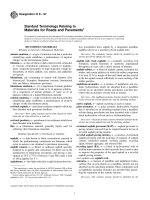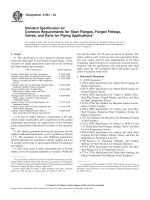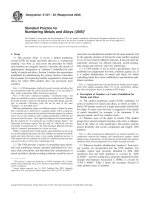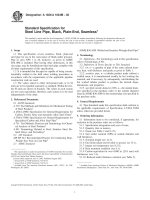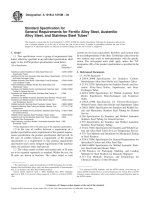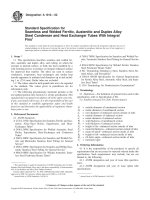Tiêu chuẩn ASTM A105 A105m 02 ;QTEWNS0WMG
Bạn đang xem bản rút gọn của tài liệu. Xem và tải ngay bản đầy đủ của tài liệu tại đây (35.54 KB, 5 trang )
Endorsed by
Manufacturers Standardization Society
of the Valve and Fittings Industry
Used in USDOE-NE Standards
Designation: A 105/A 105M – 02
Standard Specification for
Carbon Steel Forgings for Piping Applications1
This standard is issued under the fixed designation A 105/A 105M; the number immediately following the designation indicates the year
of original adoption or, in the case of revision, the year of last revision. A number in parentheses indicates the year of last reapproval.
A superscript epsilon (e) indicates an editorial change since the last revision or reapproval.
This standard has been approved for use by agencies of the Department of Defense.
1. Scope *
1.1 This specification2 covers forged carbon steel piping
components for ambient- and higher-temperature service in
pressure systems. Included are flanges, fittings, valves, and
similar parts ordered either to dimensions specified by the
purchaser or to dimensional standards such as the ASME and
API specifications referenced in Section 2. Forgings made to
this specification are limited to a maximum weight of 10 000
lb [4540 kg]. Larger forgings may be ordered to Specification
A 266/A 266M. Tubesheets and hollow cylindrical forgings for
pressure vessel shells are not included within the scope of this
specification. Although this specification covers some piping
components machined from rolled bar and seamless tubular
products (see 4.2), it does not cover raw material produced in
these product forms.
1.2 Supplementary requirements are provided for use when
additional testing or inspection is desired. These shall apply
only when specified individually by the purchaser in the order.
1.3 Specification A 266/A 266M covers other steel forgings
and Specifications A 675 and A 696 cover other steel bars.
1.4 This specification is expressed in both inch-pound units
and SI units. However, unless the order specifies the applicable
“M” specification designation (SI units), the material shall be
furnished to inch-pound units.
1.5 The values stated in either inch-pound units or SI are to
be regarded separately as standard. Within the text, the SI units
are shown in brackets. The values stated in each system are not
exact equivalents; therefore, each system must be used independently of the other. Combining values from the two systems
may result in nonconformance with the specification.
NOTE 1—The dimensionless designator NPS (nominal pipe size) has
been substituted in this standard for such traditional terms as “nominal
diameter,” “size,” and “nominal size.”
2. Referenced Documents
2.1 In addition to those reference documents listed in
Specification A 961, the following list of standards apply to
this specification:
2.2 ASTM Standards:
A 266/A 266M Specification for Carbon Steel Forgings for
Pressure Vessel Components3
A 370 Test Methods and Definitions for Mechanical Testing
of Steel Products4
A 675/A 675M Specification for Steel Bars, Carbon, HotWrought, Special Quality, Mechanical Properties3
A 696 Specification for Steel Bars, Carbon, Hot-Wrought or
Cold-Finished, Special Quality, for Pressure Piping Components3
A 788 Specification for Steel Forgings, General Requirements3
A 961 Specification for Common Requirements for Steel
Flanges, Forged Fittings, Valves, and Parts for Piping
Applications5
2.3 MSS Standards:
SP 44 Standard for Steel Pipe Line Flanges6
2.4 ASME Standards:
B16.5 Dimensional Standards for Steel Pipe Flanges and
Flanged Fittings7
B16.9 Wrought Steel Buttwelding Fittings7
B16.10 Face-to-Face and End-to-End Dimensions of Ferrous Valves7
B16.11 Forged Steel Fittings, Socket Weld, and Threaded7
1
This specification is under the jurisdiction of ASTM Committee A01 on Steel,
Stainless Steel and Related Alloys and is the direct responsibility of Subcommittee
A01.22 on Steel Forgings and Wrought Fittings for Piping Applications and Bolting
Materials for Piping and Special Purpose Applications.
Current edition approved Nov. 10, 2002. Published November 2002. Originally
published as A 105 – 26 T. Last previous edition A 105/A 105M – 01.
2
For ASME Boiler and Pressure Vessel Code applications see related Specification SA-105 in Section II of that Code.
3
Annual Book of ASTM Standards, Vol 01.05.
Annual Book of ASTM Standards, Vol 01.03.
5
Annual Book of ASTM Standards, Vol 01.01.
6
Available from Manufacturers Standardization Society of the Valve and Fittings
Industry (MSS), 127 Park St., NE, Vienna, VA 22180-4602.
7
Available from American Society of Mechanical Engineers (ASME), ASME
International Headquarters, Three Park Ave., New York, NY 10016-5990.
4
*A Summary of Changes section appears at the end of this standard.
Copyright © ASTM International, 100 Barr Harbor Drive, PO Box C700, West Conshohocken, PA 19428-2959, United States.
1
A 105/A 105M – 02
B16.34 Valves-Flanged, Threaded and Welding End7
B16.47 Large Diameter Steel Flanges7
2.5 ASME Boiler and Pressure Vessel Code:
Section IX Welding Qualifications7
2.6 API Standards:
API-600 Flanged and Butt-Welding-End Steel Gate Valves8
API-602 Compact Design Carbon Steel Gate Valves for
Refinery Use8
TABLE 1 Chemical Requirements
NOTE—For each reduction of 0.01 % below the specified carbon
maximum (0.35 %), an increase of 0.06 % manganese above the specified
maximum (1.05 %) will be permitted up to a maximum of 1.35 %.
Element
Composition, %
Carbon
Manganese
Phosphorus
Sulfur
Silicon
Copper
Nickel
Chromium
Molybdenum
Vanadium
Columbium
3. Ordering Information
3.1 See Specification A 961.
3.1.1 Additional requirements (see 12.2).
4. General Requirements
4.1 Product furnished to this specification shall conform to
the requirements of Specification A 961, including any supplementary requirements that are indicated in the purchase order.
Failure to comply with the requirements of Specification A 961
constitutes nonconformance with this specification. In case of
a conflict between the requirements of this specification and
Specification A 961, this specification shall prevail.
4.2 Except as permitted by Section 6 in Specification A 961,
the finished product shall be a forging as defined in the
Terminology Section of Specification A 788.
0.35 max
0.60–1.05
0.035 max
0.040 max
0.10–0.35
0.40 maxA
0.40 maxA
0.30 maxA,B
0.12 maxA,B
0.08 max
0.02 max
A
The sum of copper, nickel, chromium, molybdenum and vanadium shall not
exceed 1.00 %.
B
The sum of chromium and molybdenum shall not exceed 0.32 %.
TABLE 2 Mechanical RequirementsA
Tensile strength, min, psi [MPa]
Yield strength, min, psi [MPa]B
Elongation in 2 in. or 50 mm, min, %:
Basic minimum elongation for walls 5⁄16 in. [7.9 mm]
and over in thickness, strip tests.
When standard round 2-in. or 50-mm gage length or
smaller proportionally sized specimen with the gage
length equal to 4D is used
For strip tests, a deduction for each 1⁄32-in. [0.8-mm]
decrease in wall thickness below 5⁄16 in. [7.9 mm]
from the basic minimum elongation
of the percentage points of Table 3
Reduction of area, min, %D
Hardness, HB, max
5. Heat Treatment
5.1 Heat treatment is not a mandatory requirement of this
specification except for the following piping components:
5.1.1 Flanges above Class 300,9
5.1.2 Flanges of special design where the design pressure at
the design temperature exceeds the pressure-temperature ratings of Class 300, Group 1.1,
5.1.3 Flanges of special design where the design pressure or
design temperature are not known,
5.1.4 Piping components other than flanges which meet
both of the following criteria: (1) over NPS 4 and (2) above
Class 300, and
5.1.5 Piping components of Special Class10 other than
flanges which meet both of the following criteria: (1) over NPS
4 and (2) when the working pressure at the operating temperature exceeds the tabulated values for Special Class 300, Group
1.1.
5.2 Heat treatment, when required by 5.1 shall be annealing,
normalizing, or normalizing and tempering or quenching and
tempering in accordance with Specification A 961.
70 000 [485]
36 000 [250]
30
22
1.50C
30
187
A
For small forgings, see 7.3.4.
Determined by either the 0.2 % offset method or the 0.5 % extension-underload method.
C
See Table 3 for computed minimum values.
D
For round specimens only.
B
TABLE 3 Computed Minimum Values
Wall Thickness
in.
mm
Elongation in 2 in. or 50
mm, min, %
(0.312)
(0.281)
⁄ (0.250)
7⁄32 (0.219)
3⁄16 (0.188)
5⁄32 (0.156)
1⁄8 (0.125)
3⁄32 (0.094)
1⁄16 (0.062)
7.9
7.1
6.4
5.6
4.8
4.0
3.2
2.4
1.6
30.00
28.50
27.00
25.50
24.00
22.50
21.00
19.50
18.00
⁄
⁄
5 16
9 32
14
Note—The above table gives the computed minimum elongation values for
each 1⁄32-in. [0.8-mm] decrease in wall thickness. Where the wall thickness lies
between two values shown above, the minimum elongation value is determined by
the following equation:
6. Chemical Composition
6.1 The steel shall conform to the chemical requirements
specified in Table 1.
6.2 Steels to which lead has been added shall not be used.
E 5 48T 1 15.00
where:
E = elongation in 2 in. or 50 mm, %, and
T = actual thickness of specimen, in. [mm].
7. Mechanical Properties
7.1 The material shall conform to the mechanical property
requirements prescribed in Table 2 and Table 3.
8
Available from The American Petroleum Institute (API), 1220 L. St., NW,
Washington, DC 20005.
9
For definition of Class 300, see ASME B16.5.
10
For definition of special class, see ASME B16.34.
7.2 For normalized, normalized and tempered, or quenched
and tempered forgings, the central axis of the test specimen
shall correspond to the 1⁄4 T plane or deeper position, where T
2
A 105/A 105M – 02
8. Hydrostatic Tests
8.1 Such tests shall be conducted by the forging manufacturer only when Supplementary Requirement S8 in Specification A 961 is specified.
is the maximum heat-treated thickness of the represented
forging. In addition, for quenched and tempered forgings, the
midlength of the test specimen shall be at least T from any
second heat-treated surface. When section thickness does not
permit this positioning, the test specimen shall be positioned as
near as possible to the prescribed location.
7.3 Tension Tests:
7.3.1 One tension test shall be made for each heat of
as-forged components.
7.3.2 One tension test shall be made from each heat-treating
charge. If more than one heat is included in such a charge, each
heat shall be tested.
7.3.2.1 When the heat-treating temperatures are the same
and the furnaces (either batch or continuous type), are controlled within 625°F [614°C] and equipped with recording
pyrometers so that complete records of heat treatment are
available, then one tension test from each heat is required
instead of one test from each heat in each heat-treatment
charge. The test specimen material shall be included with a
furnace charge.
7.3.3 Testing shall be performed in accordance with Test
Methods and Definitions A 370. The largest feasible round
specimen as described in Test Methods and Definitions A 370
shall be used except when hollow cylindrically shaped parts are
machined from seamless tubulars. The gage length for measuring elongation shall be four times the diameter of the test
section. When hollow cylindrically shaped parts are machined
from seamless tubular materials, strip tests may be used.
7.3.4 Forgings too small to permit obtaining a subsize
specimen of 0.250 in. [6.35 mm] diameter or larger (see Test
Methods and Definitions A 370) parallel to the dimension of
maximum working, and produced in equipment unsuitable for
the production of a separately forged test bar such as an
automatic or semi-automatic press, may be accepted on the
basis of hardness only. One percent of the forgings per lot (see
Note 2), or ten forgings, whichever is the lesser number, shall
be selected at random, prepared, and tested using the standard
Brinell test in Test Methods and Definitions A 370. The
locations of the indentations shall be at the option of the
manufacturer but shall be selected to be representative of the
forging as a whole. One indentation per forging shall be
required but additional indentations may be made to establish
the representative hardness. The hardness of all forgings so
tested shall be 137 to 187 HB inclusive.
9. Retreatment
9.1 If the results of the mechanical tests do not conform to
the requirement specified, the manufacturer may heat treat or
reheat treat the forgings as applicable and repeat the test
specified in Section 7.
10. Repair by Welding
10.1 Repair of defects by the manufacturer is permissible
for forgings made to dimensional standards such as those of
ASME or for other parts made for stock by the manufacturer.
Prior approval of the purchaser is required to repair-weld
special forgings made to the purchaser’s requirements.
10.2 Weld repairs shall be made by a process that does not
produce undesirably high levels of hydrogen in the welded
areas.
10.3 All forgings repaired by welding shall be post-weld
heat treated between 1100°F [593°C] and the lower transformation temperature for a minimum of 1⁄2 h/in. [1⁄2 h/25.4 mm]
of maximum section thickness, or alternatively annealed,
normalized and tempered, or quenched and tempered. If the
forging was not previously heat treated, the original tempering
temperature was exceeded, or the forging was fully heat treated
in the post weld cycle, then the forging shall be tested in
accordance with Section 7 on completion of the cycle.
10.4 The mechanical properties of the procedurequalification weldment shall, when tested in accordance with
Section IX of the ASME Boiler and Pressure Vessel Code,
conform with the requirements listed in Table 2 for the thermal
condition of repair-welded forgings.
11. Rejection and Rehearing
11.1 Each forging that develops injurious defects during
shop working or application shall be rejected and the manufacturer notified.
12. Certification
12.1 Identification Marking—For forgings made to specified dimensions, when agreed upon by the purchaser, and for
forgings made to dimensional standards, application of identification marks as required in Specification A 961 shall be the
certification that the forgings have been furnished in accordance with the requirements of this specification. The specification designation included on test reports shall include year
date and revision letter, if any.
12.2 Test Reports—When test reports are required, the
manufacturer shall also provide the following, where applicable:
12.2.1 Type heat treatment, Section 5,
12.2.2 Tensile property results, Section 7 (Table 2), report
the yield strength and ultimate strength, in ksi [MPa], elongation and reduction in area, in percent,
12.2.3 Chemical analysis results, Section 6 (Table 1). When
the amount of an unspecified element is less than 0.02 %, then
the analysis for that element may be reported as “< 0.02 %,”
NOTE 2—A lot is defined as the product from a mill heat or if heat
treated, the product of a mill heat per furnace charge.
7.4 Hardness Tests—Except when only one forging is
produced, a minimum of two forgings shall be hardness tested
per batch or continuous run as defined in 7.3.2.1 to ensure that
forgings are within the hardness limits given in Table 2. When
only one forging is produced, it shall be hardness tested as
defined in 7.3.2.1 to ensure it is within the hardness limits
given in Table 2. Testing shall be in accordance with Test
Methods and Definitions A 370. The purchaser may verify that
the requirement has been met by testing at any location on the
forging, provided such testing does not render the forging
useless.
3
A 105/A 105M – 02
12.2.4 Hardness results, Section 7 (Table 2), and
12.2.5 Any supplementary testing required by the purchase
order.
13.4 Bar Coding—In addition to the requirements in
Specification A 961 and 13.3, bar coding is acceptable as a
supplemental identification method. The purchaser may
specify in the order a specific bar coding system to be used.
The bar coding system, if applied at the discretion of the
supplier, should be consistent with one of the published
industry standards for bar coding. If used on small parts, the
bar code may be applied to the box or a substantially applied
tag.
13. Product Marking
13.1 If the forgings have been quenched and tempered, the
letters “QT” shall be stamped on the forgings following this
specification number.
13.2 Forgings repaired by welding shall be marked with the
letter “W” following this specification number.
13.3 When test reports are required for larger products, the
markings shall consist of the manufacturer’s symbol or name,
this specification number, and such other markings as necessary to identify the part with the test report (13.1 and 13.2 shall
apply). The specification number marked on the forgings need
not include specification year date and revision letter.
14. Keywords
14.1 pipe fittings, steel; piping applications; pressure containing parts; steel flanges; steel forgings, carbon; steel valves;
temperature service applications, elevated; temperature service
applications, high
SUPPLEMENTARY REQUIREMENTS
The following supplementary requirements shall apply only when specified by the purchaser in the
inquiry, contract, and order.
S1. Hardness
S1.1 The purchaser may check the hardness of any or all
forgings supplied at any location on the forging and the
hardness shall be 137 to 187 HB. All forgings not within the
specified hardness range shall be rejected.
S3. Marking Small Forgings
S3.1 For small products where the space for marking is less
than 1 in. [25 mm] in any direction, test reports are mandatory
and marking may be restricted to only such symbols or codes
as are necessary to identify the parts with test reports.
S3.2 When the configuration or size does not permit marking directly on the forging, the marking method shall be a
matter of agreement between the manufacturer and the purchaser.
S2. Heat Treatment
S2.1 All forgings shall be heat treated as specified by the
purchaser.
S2.2 When forgings not requiring heat treatment by 5.1 are
supplied heat treated by purchaser request, the basis for
determining conformance with Table 2 and Table 3 shall be
hardness testing per 7.4 and either (1) tensile testing of heat
treated forgings per 7.2, or (2) tensile tests from as-forged
forgings or separately forged test blanks, as agreed upon
between the supplier and purchaser.
S2.3 When test reports are required, and tensile test results
were obtained from as-forged forgings or as-forged test blanks,
it shall be so indicated on the test report.
S2.4 In addition to the marking required by Section 13, this
specification shall be followed by the letter: A for annealed, N
for normalized, NT for normalized and tempered, or QT for
quenched and tempered, as appropriate.
S4. Carbon Equivalent
S4.1 The maximum carbon equivalent, based on heat analysis, shall be 0.47 for forgings with a maximum section
thickness of 2 in. or less, and 0.48 for forgings with a
maximum section thickness of greater than 2 in.
S4.2 Determine the carbon equivalent (CE) as follows:
CE 5 C 1 Mn/6 1 ~Cr 1 Mo 1 V!/5 1 ~Ni 1 Cu!/15
S4.3 A lower maximum carbon equivalent may be agreed
upon between the supplier and the purchaser.
4
A 105/A 105M – 02
SUMMARY OF CHANGES
Committee A01 has identified the location of changes to this standard since the last issue (A 105/A 105M-01)
that may impact the use of this standard.
(1) Deleted reference to Specification A 695 in 1.3 and 2.2.
ASTM International takes no position respecting the validity of any patent rights asserted in connection with any item mentioned
in this standard. Users of this standard are expressly advised that determination of the validity of any such patent rights, and the risk
of infringement of such rights, are entirely their own responsibility.
This standard is subject to revision at any time by the responsible technical committee and must be reviewed every five years and
if not revised, either reapproved or withdrawn. Your comments are invited either for revision of this standard or for additional standards
and should be addressed to ASTM International Headquarters. Your comments will receive careful consideration at a meeting of the
responsible technical committee, which you may attend. If you feel that your comments have not received a fair hearing you should
make your views known to the ASTM Committee on Standards, at the address shown below.
This standard is copyrighted by ASTM International, 100 Barr Harbor Drive, PO Box C700, West Conshohocken, PA 19428-2959,
United States. Individual reprints (single or multiple copies) of this standard may be obtained by contacting ASTM at the above
address or at 610-832-9585 (phone), 610-832-9555 (fax), or (e-mail); or through the ASTM website
(www.astm.org).
5
